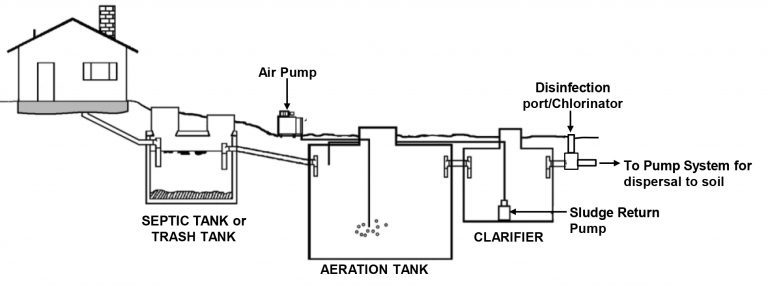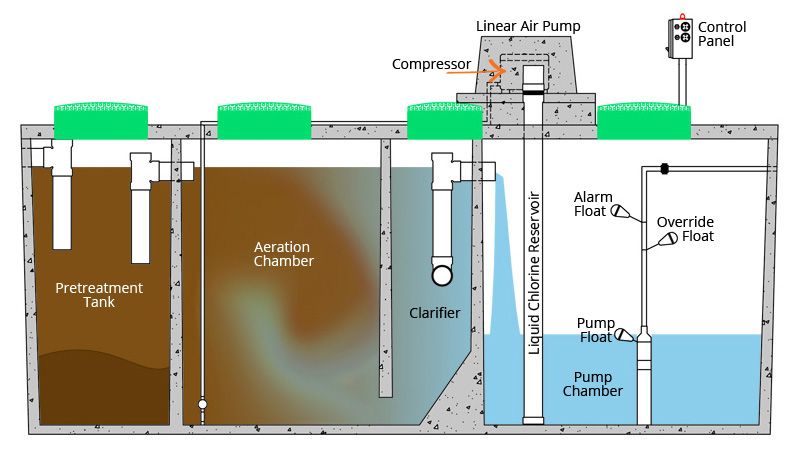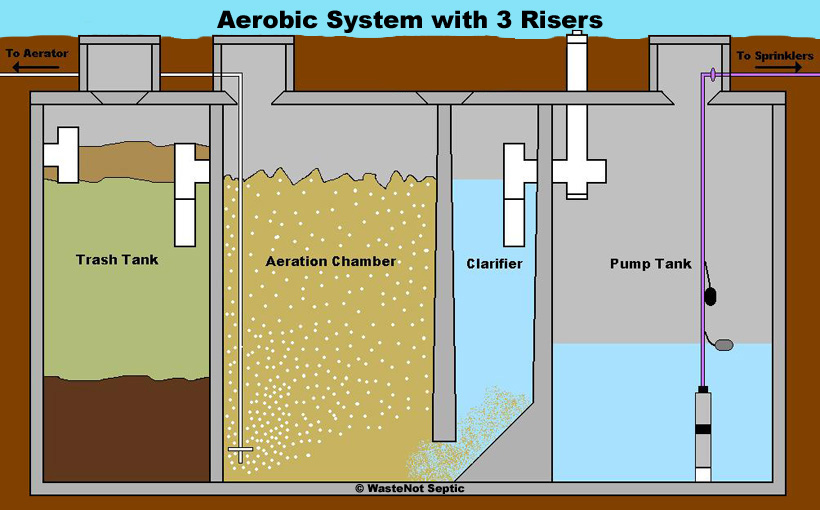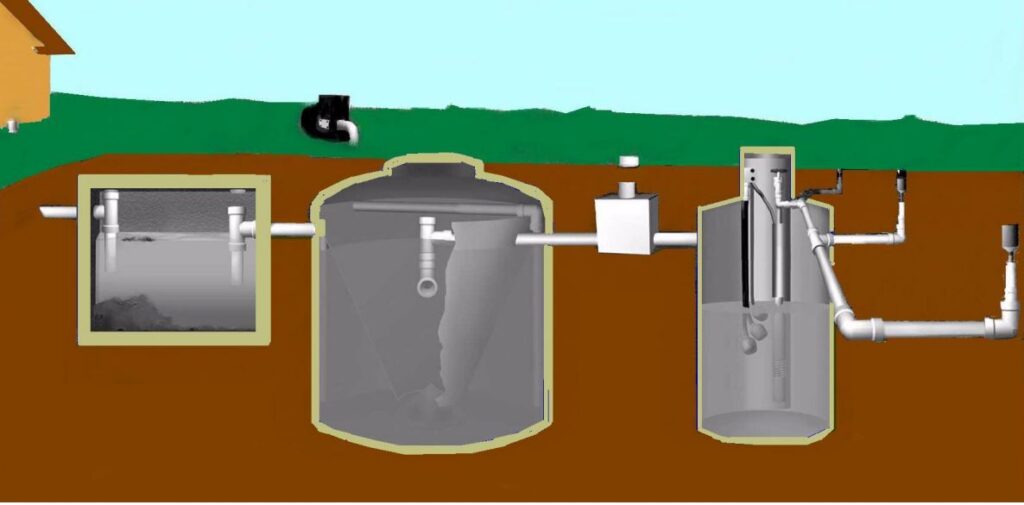So, you’re curious about the 3 tank aerobic septic system, huh? Well, you’ve come to the right place! In this article, we’ll dive into the ins and outs of this septic system and provide you with a comprehensive diagram to help you understand it better. Whether you’re a homeowner looking to install a new septic system or just interested in learning more about how they work, we’ve got you covered.
In the next few paragraphs, we’ll break down the different components of the 3 tank aerobic septic system and explain how each part functions. From the primary tank to the aerator tank and the clarifier tank, we’ll walk you through the entire process. We’ll also discuss the advantages of this type of septic system and any maintenance requirements you should be aware of. By the end of this article, you’ll have a clear understanding of the 3 tank aerobic septic system and the role it plays in properly treating and disposing of wastewater. So, let’s get started!

What is a 3 Tank Aerobic Septic System?
Definition of a 3 Tank Aerobic Septic System
A 3 Tank Aerobic Septic System is a wastewater treatment system that uses the natural process of aerobic bacteria to break down and treat sewage. Unlike conventional septic systems, which rely on anaerobic bacteria, the aerobic septic system introduces oxygen into the treatment process, allowing for more efficient decomposition of organic matter.
Components of a 3 Tank Aerobic Septic System
A 3 Tank Aerobic Septic System consists of three main components: the primary tank, the aeration tank, and the clarifier tank. The primary tank is where the initial settling of solids occurs, separating the heavier solids from the wastewater. The aeration tank is where the aerobic bacteria thrive, breaking down the organic matter through oxygenation. Finally, the clarifier tank is responsible for further separating the clarified effluent from any remaining solids before it is discharged.
How Does a 3 Tank Aerobic Septic System Work?
Aerobic Bacterial Processes
The key to the 3 Tank Aerobic Septic System’s functionality lies in the aerobic bacterial processes that take place within the system. Unlike anaerobic bacteria, which thrive in oxygen-deprived conditions, aerobic bacteria require oxygen to survive and perform their role in wastewater treatment. With the introduction of oxygen, the aerobic bacteria are able to break down the organic matter much more efficiently, resulting in a higher treatment efficiency.
Each Tank’s Role in the System
Each tank within the 3 Tank Aerobic Septic System has its own specific role in the treatment process. The primary tank serves as the first stage of treatment, allowing for the separation of solids from the wastewater. The aeration tank is where the aerobic bacteria are introduced and where the majority of the treatment occurs. Finally, the clarifier tank serves as the last stage of treatment, allowing for the further clarification of effluent before it is discharged.
Flow of Wastewater in the System
The flow of wastewater within a 3 Tank Aerobic Septic System is a carefully designed process. Initially, the wastewater enters the primary tank, where the heavier solids settle at the bottom and are retained, while the lighter scum floats to the top. The partially clarified wastewater then flows into the aeration tank, where the aerobic bacteria are introduced. In this tank, the wastewater is continuously mixed and aerated, allowing the bacteria to decompose the organic matter. Finally, the clarified effluent flows into the clarifier tank, where any remaining solids settle to the bottom, and the clear effluent rises to the top for discharge.
Advantages of a 3 Tank Aerobic Septic System
Higher Treatment Efficiency
One of the main advantages of a 3 Tank Aerobic Septic System is its higher treatment efficiency compared to traditional septic systems. The aerobic bacteria thrive in the presence of oxygen, allowing them to break down the organic matter more effectively. This results in a higher level of treatment, reducing the contaminants in the wastewater and producing a cleaner effluent.
Reduced Nitrate Levels
Another advantage of the 3 Tank Aerobic Septic System is its ability to reduce nitrate levels in the effluent. Nitrate, a common contaminant found in wastewater, can be harmful to human health and the environment. The aerobic bacteria in the system convert the nitrogen compounds present in the wastewater into harmless nitrogen gas, thus reducing the nitrate levels in the effluent.
Lower Maintenance Requirements
Compared to conventional septic systems, 3 Tank Aerobic Septic Systems have lower maintenance requirements. The continuous aeration and mixing in the aeration tank help prevent the buildup of solids and scum, reducing the frequency of tank cleanings. Additionally, the aerobic bacteria in the system digest the organic matter more efficiently, resulting in less frequent pump-outs.
Installation and Set-Up of a 3 Tank Aerobic Septic System
Determining Proper Location
When installing a 3 Tank Aerobic Septic System, it is crucial to determine the proper location for the system. Factors such as soil type, groundwater level, and proximity to water sources need to be considered. The system should be installed in an area with well-drained soil and at a safe distance from water sources to minimize the risk of contamination.
Excavation and Tank Placement
The installation process involves excavating the area for the tanks and properly placing them. The primary tank should be placed at the inlet of the system, followed by the aeration tank and the clarifier tank in sequential order. Each tank should be level and securely placed to ensure proper functionality.
Connecting the System to the Household Plumbing
Once the tanks are in place, the next step is to connect the system to the household plumbing. This involves diverting the wastewater from the home’s plumbing to the primary tank of the aerobic system. Proper plumbing connections need to be made to ensure the wastewater flows smoothly into the system.

Regular Maintenance and Monitoring
Inspecting and Cleaning the Tanks
Regular inspection and cleaning of the tanks are essential for maintaining the functionality of a 3 Tank Aerobic Septic System. The primary tank should be inspected for any buildup of solids and scum and cleaned as necessary. Similarly, the aeration tank and clarifier tank should be regularly inspected and cleaned to ensure optimal treatment efficiency.
Checking Electrical Components
A 3 Tank Aerobic Septic System relies on electrical components, such as the air pump, to provide the necessary oxygen for the aerobic bacteria. Regular checks of these electrical components are important to ensure they are functioning properly. Any malfunctioning components should be repaired or replaced promptly to prevent disruptions in the treatment process.
Monitoring the Air Pump
The air pump is a critical component of a 3 Tank Aerobic Septic System as it provides the necessary oxygen for the bacteria to thrive. Regular monitoring of the air pump’s performance is crucial to ensure adequate oxygenation of the wastewater. Unusual noises or decreased airflow should be addressed immediately to maintain the system’s efficiency.
Understanding the Risks and Limitations of a 3 Tank Aerobic Septic System
Potential Issues and Failures
While a 3 Tank Aerobic Septic System offers several advantages, it is not without its risks and limitations. Potential issues that can arise include clogging of the aeration system, excessive sludge accumulation, and mechanical failures. Regular maintenance and monitoring can help identify these issues early and prevent system failures.
Groundwater Contamination Risks
Proper installation and maintenance are crucial to minimize the risk of groundwater contamination associated with 3 Tank Aerobic Septic Systems. Inadequate installation or failure to address system issues promptly can result in the release of untreated wastewater into the groundwater, posing a threat to public health and the environment.
Proper System Sizing
Another limitation of the 3 Tank Aerobic Septic System is the importance of proper system sizing. The size of the system should be based on the household’s wastewater flow, ensuring that it can adequately handle the volume of wastewater generated. Undersized systems can lead to reduced treatment efficiency, while oversized systems can be unnecessarily costly.

Comparing a 3 Tank Aerobic Septic System to Other Systems
Differences with Conventional Septic Systems
Compared to conventional septic systems, the 3 Tank Aerobic Septic System offers several significant differences. The introduction of oxygen in the aerobic system allows for more efficient decomposition of organic matter, resulting in a higher treatment efficiency. Additionally, the aerobic system reduces nitrate levels in the effluent, which is not a feature of conventional septic systems.
Advantages over Conventional Septic Systems
The 3 Tank Aerobic Septic System provides several advantages over conventional septic systems. The higher treatment efficiency results in cleaner effluent, reducing the environmental impact. The system also requires lower maintenance due to the continuous aeration and mixing, reducing the frequency of tank cleanings. Furthermore, the decreased nitrate levels in the effluent contribute to improved water quality.
Differences with Advanced Treatment Units
Advanced treatment units, such as sand filters or disinfection systems, offer additional treatment beyond what the 3 Tank Aerobic Septic System provides. These units can further treat the effluent to a higher degree, making them suitable for areas with stricter water quality requirements. However, the complexity and higher maintenance needs of advanced treatment units should be taken into consideration.
Environmental Implications of a 3 Tank Aerobic Septic System
Impact on Water Quality
One of the key environmental implications of a 3 Tank Aerobic Septic System is its impact on water quality. The aerobic treatment process results in cleaner effluent, reducing the contaminants that enter water bodies. This improved water quality helps protect aquatic ecosystems and ensures the safety of drinking water sources.
Effluent Disposal Options
The disposal of effluent from a 3 Tank Aerobic Septic System requires careful consideration to minimize environmental impacts. Depending on local regulations and site conditions, various disposal options may be available, including subsurface disposal through soil absorption systems or the use of alternative treatment technologies. Proper effluent disposal is crucial to prevent groundwater contamination and protect the environment.
Protection of Aquatic Ecosystems
Implementing a 3 Tank Aerobic Septic System helps protect aquatic ecosystems from the harmful effects of untreated wastewater discharge. The higher treatment efficiency of the system ensures that fewer contaminants reach water bodies, reducing the risk of eutrophication, which can harm fish and other aquatic organisms. By minimizing pollution, the system contributes to the overall health of ecosystems.

Regulations and Permits for a 3 Tank Aerobic Septic System
Local Health Department Requirements
The installation and operation of a 3 Tank Aerobic Septic System are subject to local health department requirements. These requirements will vary depending on the location and may include regulations regarding system sizing, setback distances, and maintenance. It is important to consult with the local health department to ensure compliance with all necessary regulations.
Obtaining Necessary Permits
Before installing a 3 Tank Aerobic Septic System, it is essential to obtain the necessary permits from the relevant authorities. This typically involves submitting site plans, system specifications, and other required documents for review and approval. Failure to obtain the required permits can result in legal consequences and delays in system installation.
Compliance with Environmental Regulations
In addition to health department requirements, compliance with environmental regulations is crucial when installing and operating a 3 Tank Aerobic Septic System. These regulations aim to protect the environment and ensure the proper treatment and disposal of wastewater. It is important to stay informed about any relevant environmental regulations and maintain compliance throughout the system’s lifespan.
Conclusion
Understanding the 3 Tank Aerobic Septic System is essential for homeowners, installers, and regulators alike. This comprehensive diagram has highlighted the key components, functionality, and advantages of the system. By utilizing aerobic bacterial processes, the 3 Tank Aerobic Septic System offers higher treatment efficiency, reduced nitrate levels, and lower maintenance requirements. Proper installation, maintenance, and monitoring are crucial for the system’s success and to minimize the risks associated with improper functioning. By complying with regulations and considering the environmental implications, the 3 Tank Aerobic Septic System can be a reliable and sustainable wastewater treatment option.

